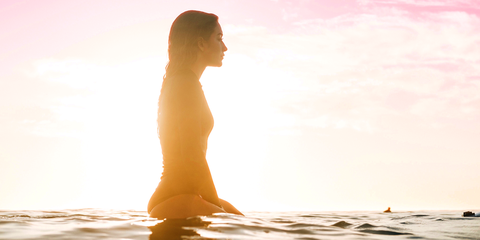Define American presents a short film about Latina surfers and why seeing yourself in the sport you love matters. By Define American AUG 29, 2018

DEFINE AMERICAN/BRIANNA ELLIS-MITCHELL
What comes to mind when you hear the word “surfing”?
If the answer is a ripped white man cruising along the California coast, you’re not alone — but that doesn’t mean there aren’t women of color out on the waves. That’s why the media and culture organization Define American, whose mission is to use “the power of story to transcend politics and shift the conversation about immigrants, identity, and citizenship in a changing America,” tapped a young Latina surfer and her coach to talk about representation, the history of surfing, and their love of the sport for the short film “Water Warrior.” Below, filmmaker Monica Medellin — a Latina surfer herself — shares what inspired her to make the film, and why seeing someone who looks like you doing the thing you love can be life-changing. Water Warrior by Shondaland USPlayUnmuteCurrent Time 0:01/Duration 3:35Loaded: 5.76% CaptionsFullscreen CLICK TO UNMUTE
“Surfing and filmmaking are my life. Most days, I wake up and surf in Venice Beach before heading to work at Define American, the nation’s leading media and culture organization dedicated to humanizing immigrants. I’ve always looked for opportunities to marry my passion for sports with my love of filmmaking in a way that bridges cultures, communities, and perspectives. With this film, I had the opportunity to do just that.
I’ve been an athlete since I was a child, but surfing was not an obvious choice for me. My mother is an immigrant from Mexico, a single mom, and a public school teacher who worked hard every day to make ends meet. But she wanted me to have every opportunity for success so she sought out scholarships to sports camps and afterschool programs. It started with gymnastics and volleyball — and then I discovered surfing. I fell in love immediately and was doing headstands on my board by the time I was 12. I’ve been a surfer girl ever since. ADVERTISEMENT – CONTINUE READING BELOW
But as I spent more time in the sport, I started noticing the very clear divisions within it. Girls were told to surf in the “whitewash,” an easier area where we could touch the bottom if necessary, while the boys were farther out in a more advanced area — where I wanted to be. I’d make a point to push myself the way I’d see the male counselors push the boys, despite not having female counselors to do the same for me. When I later became a surf camp counselor in high school, I was the sole female instructor and the only Latina. I noticed that the younger girls gravitated towards me — the way I would have done had I had someone to look up to. Their parents would even call ahead every summer to make sure that I was going to be working there, proof that my presence alone made a difference.
In many places, surfing wasn’t just a sport, but a sacred cultural act.
While all this played out at camp, I also faced the realities of surfing while Latina at my high school. Thanks to a scholarship, I attended a private school in Los Angeles, where I was asked why I only played “white people sports.” It wasn’t until college that I met a fellow Latina surfer, Olivia Vandamme, the coach we meet in “Water Warrior.” Meeting Olivia and seeing there was another girl who looked like me and loved surfing was the first time I didn’t feel so alone. She shared the most beautiful and detailed stories about how indigenous people around the world have always loved to play in the waves, about how women would often lead the charge in paddle-outs. About how, in many places, surfing wasn’t just a sport, but a sacred cultural act. Hearing those stories expanded my understanding of surfing. For the first time, I finally felt that I belonged in the waves.
Through her work at City Surf Project, Olivia continues to extend that same sense of belonging to underrepresented youth by giving them access to surf equipment and connecting them to the rich, indigenous history of surfing. But Olivia lives in the Bay Area, which meant I still had to work to find a surf community of my own in Los Angeles. A friend introduced me to a multi-ethnic surf community where I’ve met some of my closest girlfriends; other women of color who love to surf, skate, and shred just like me. Together, we recently founded a content creation company called The Gnar Gnar Honeys, which was born from our love of surfing and skating. Now, we use this platform to create action sports videos centered around diverse women and girls — the kind of representation we’d been looking for all our lives.
If I had seen more diverse images in surfing when I was a kid, I would not have struggled with feeling like I didn’t belong in this sport as a Mexican-American woman. To anyone who was told a sport wasn’t for you because you didn’t fit the typical look, I hope “Water Warrior” inspires you to play anyway. And to all of the girls of color heading to the ocean or the skate park, I hope this film helps you see that you deserve to be there as much as anybody else does. Never be afraid to claim your space.
For more information about the history of surfing, check out some of the following resources:
- Riding the Native Wave: Surfing’s Hidden Roots in Peru
- Surfing and Indigeneity
- The Critical Surf Studies Reader
Monica Medellin is a surfer, filmmaker, and video producer for Define American.